Conshilía Purpháidhe: Difference between revisions
Tag: 2017 source edit |
|||
| (29 intermediate revisions by the same user not shown) | |||
| Line 1: | Line 1: | ||
{{wip}} | {{wip}} | ||
{{Infobox executive government | {{Infobox executive government | ||
| government_name = | | government_name = Conshilía Purpháidhe | ||
| nativename= | | nativename= | ||
| border = | | border = | ||
| image = [[File:purpaida.png|200px]] | | image = [[File:purpaida.png|200px]] | ||
| caption=Logo of the | | caption=Logo of the Conshilía Purpháidhe | ||
| date = | | date = | ||
| state = [[Urcea|Apostolic Kingdom of Urcea]] | | state = [[Urcea|Apostolic Kingdom of Urcea]] | ||
| address = [[Julian Palace]]<br>[[Urceopolis]] | | address = [[Julian Palace]]<br>[[Urceopolis (City)|Urceopolis]] | ||
| appointed = [[Chancellor and Temporary President]] | | appointed = [[Chancellor and Temporary President]] | ||
| leader_title = [[Procurator]] | | leader_title = [[Procurator]] | ||
| Line 17: | Line 16: | ||
| url = https://www.purpaida.urc/ | | url = https://www.purpaida.urc/ | ||
}} | }} | ||
The '''Conshilía Purpháidhe''' (lit. ''Purple Council'', commonly simply called "'''the Purpháidhe'''") is the collective organizing body of [[Apostolic King of Urcea|His Most Christian Majesty]]'s Government of the [[Urcea|Apostolic Kingdom of Urcea]], composed of the [[Procurator]] and the [[Government of Urcea|Government]] Ministers, the senior most officials within the Urcean national bureaucracy. The Purpháidhe is considered the Urcean equivalent of a {{wp|Cabinet (government)|cabinet}} and, taken together with its subordinate agencies and offices, is considered the ''de jure'' {{wp|executive branch}} of the [[Government of Urcea]] and is responsible for executing [[Consolidated Laws of HMCM's Kingdom and State|the Kingdom's laws]] and managing the public projects of the Kingdom. While most executive authority is exercised by the [[Procurator]], the Purpháidhe is still largely responsible for the day-to-day administration of the affairs of state. The Procurator serves as the official head of the Purpháidhe and is responsible for issuing "''Treasury Orders''" to its members, which are official directives related to the execution of the laws and administration of affairs of state. | |||
The | The Purpháidhe serves as the Royal {{wp|Privy Council}} of the [[Apostolic King of Urcea|Apostolic King]] and his household, informing the King of the affairs of state. It is within this capacity that the Purpháidhe originated and received its name; members of the Privy Council often wore purple (as a color of royalty) cockades to distinguish themselves at court and around [[Urceopolis (City)|Urceopolis]] as well as while executing authority on behalf of the King or making public appearances; the distinguishing cockade became well known and eventually the body became known by its present name, literally meaning the "Purple Council". | ||
==History== | |||
{{wip}} | {{wip}} | ||
The Conshilía Purpháidhe began in the medieval period as a relatively informal council of advisors to the [[Apostolic King of Urcea]]. The date of origin of the institution is subject to significant debate among historians given the informality of the body in its earliest form. Every Apostolic King had cliques of advisors and individuals executing their will, both in formal office (such as local sherriffs, judges, and tax collectors) or as simple courtesans. As such, some historians state that the institution began with the [[Golden Bull of 1098]] and that it was virtually indistinguishable from the King's general court. Others argue for a "late date" in the 1200s when the name "Conshilía Purpháidhe" transitioned from a nickname to an official title. In whichever case, an institutional privy council of state was in place by the end of the 13th century, and its positions were responsible for governing the Urcean state as it existed. In this form, it had varying memberships ranging from seven members to nearly thirty, and also had a judicial role as a court of appeals. The shape and function of the body continued to solidify and by the end of the 15th century, it had developed into a body of officers with the title of "Minister" with specific portfolios and individuals under them answerable to the Minister directly, somewhat comparable to the modern version of the Conshilía Purpháidhe. Ministers served entirely at the pleasure of the King, but the body was largely responsible for governing the country on the King's behalf and at the King's direction. | |||
Appointments to the Conshilía Purpháidhe received significant changes in the 18th and 19th centuries and formed an important part of the [[Constitutional history of Urcea|development of the Urcean constitution]]. In [[1747]], King Leo IV required additional taxes to be levied in support of the [[War of the Caroline Succession]], and consequently needed the support of the [[Conshilía Daoni]]. The Daoni provided the sums needed in exchange but required that appointments to the Purpháidhe be subject to the "general consent and approval" of the Daoni. This development, known as the [[Concession of 1747]], made the Purpháidhe responsible to the Daoni for the first time and also began the modern convention of members of the Daoni also sometimes serving as members of the Purpháidhe. The "general consent and approval", however, was vague enough for the Crown to bypass the Daoni on several occasions in the 18th century. In [[1805]], in the midst of the [[Second Caroline War]], the Daoni received further concession in the form of a formal vote being required to appoint members of the Purpháidhe. These two events largely solidified the form and function of the Purpháidhe as a cabinet answerable to the legislature, though the final constitutional development - appointment of the Purpháidhe by the Chancellor - would only come later in the 19th century as the office of Chancellor grew in power and relevance. | |||
The | |||
== | ==Structure== | ||
While the historic role of the Purpháidhe was that of {{wp|privy council}} to the [[Apostolic King of Urcea]], the accretion of its departments and agencies over time necessarily led to the expenditure of funds to support their activities, functionally placing the council under the direction of the Royal Treasury. As First Lord (or Lady) of the Treasury, the [[Procurator]] is the head of the Purpháidhe. He or she oversees all ministries in an administrative sense and reports directly to the King. The Procurator convenes all meetings of the Purpháidhe. | |||
Although the Conshilía Purpháidhe has met as a functionally single body for centuries, it exists as an amalgamation of several different legal bodies with the same personnel. The most prominent legal basis is that of Privy Council, while the most prominent functional basis is of the members of the Purpháidhe as Lords of the Treasury. Together, the functions and powers of both bodies give the Purpháidhe significant authority over both Kingdom-wide policy and the expenditure of funds necessary to implement those policies. | |||
===Appointments=== | |||
The members of the Conshilía Purpháidhe are nominated by the [[Chancellor and Temporary President]] of the [[Conshilía Daoni]] and are almost always also members of the Daoni. The Daoni is responsible for confirming nominees by a majority vote. The members of the Purpháidhe legally serve at the pleasure of the [[Apostolic King of Urcea]], but functionally resign their offices either when the party control of the Daoni changes or when they lose the confidence of the [[Chancellor and Temporary President]]. The two popularly elected [[Censor (Urcea)|Censors]] also sit on the Purpháidhe but typically abstain from its proceedings unless an issue relating to their mandate as public morality regulators is discussed. | |||
===Procedure=== | |||
The members of the Purpháidhe are appointed by the [[Conshilía Daoni]], but they are nominally responsible to the [[Procurator]] as head of the Privy Council and Royal Treasury. Consequently, members of the Daoni require the ''imprimatur'' of the Procurator in order to issue a binding decree or regulations considered to be major in scope. If the Procurator refuses to issue one and issues a Treasury Order contrary to the Purpháidhe minister's direction, the ministers can appeal to the [[Apostolic King of Urcea]], who has three options on how to respond: he can issue a "Writ of Compliance", ordering the Purpháidhe member to follow the Procurator's direction; he can issue a "Writ of Correction", in which the Procurator must withdraw his Treasury Order, allowing the Purpháidhe member to proceed on their own proposed course of action submitted to the King; or, the King can issue a "Writ of Dismissal", in which neither the Purpháidhe member's proposal nor the policy designed by the Procurator may be followed and that an entirely new policy must be jointly devised by both the Minister and Procurator. | |||
' | |||
===Salary=== | |||
Unlike many other [[Occidental]] government Cabinets, members of the Purpháidhe receive no salary. Historically it was anticipated that members of the {{wp|privy council}} were members of the wealthy landed aristocracy, and consequently no salary was needed to support their activities. In the [[Constitution of Urcea|constitutional period]], nearly all members of the Purpháidhe have also been salaried members of the [[Conshilía Daoni]]. In the rare cases where a Purpháidhe member is not a Daoni member, they have typically either been independently wealthy or have been assigned a {{wp|No-show job|nominal public office or Ministry post}} aside from their primary position as Minister which will pay a salary equal to the pay afforded to members of the Daoni. | |||
==Current Purpháidhe membership== | |||
== | {|class="sortable wikitable" style="text-align:center" | ||
'' | |- align=center | ||
!scope=col width=250|Ministry | |||
!scope=col class="unsortable" |Image | |||
!scope=col |Incumbent | |||
!scope=col |Party | |||
!scope=col class="unsortable" |In office | |||
|- | |||
|[[file:ProcuratorSeal2.png|150px]]<br/>'''[[Procurator]]''' | |||
|[[File:C Agricola Slim.png|130px]] | |||
|data-sort-value="Agricola" |[[Caelian Agricola]] | |||
|[[National Pact (Urcea)|National Pact]] | |||
|1 January 2026 - present | |||
|- | |||
|[[File:MoArmSer.png|150px]]<br/>'''[[Ministry of the Armed Services (Urcea)|Ministry of the Armed Services]]''' | |||
|[[File:John Faso cropped (original version) (cropped).jpg|130px]] | |||
|data-sort-value="Fendara" |Leo Glores | |||
|[[Solidarity Party (Urcea)|Solidarity Party]] | |||
|1 January 2021 - present | |||
|- | |||
|[[File:MinofSt.png|150px]]<br/>'''[[Ministry of State (Urcea)|Ministry of State]]''' | |||
|[[File:Gallivan -patrick.jpg|130px]] | |||
|data-sort-value="Fendara" |[[Gareth Fendara]] | |||
|[[Solidarity Party (Urcea)|Solidarity Party]] | |||
|1 January 2021 - present | |||
|- | |||
|[[File:MinofAd.png|150px]]<br/>'''[[Ministry of Administration of the Realm (Urcea)|Ministry of Administration of the Realm]]''' | |||
|[[File:Elizabeth Dole official photo.jpg|130px]] | |||
|data-sort-value="Annán" |Anaroia Annán | |||
|[[Solidarity Party (Urcea)|Solidarity Party]] | |||
|1 January 2021 - present | |||
|- | |||
|[[File:ColSci.png|150px]]<br/>'''[[Collegium Scientificum]]''' | |||
|[[File:Barron250-e1436470778331.jpg|130px]] | |||
|data-sort-value="Fox" |Fr. Seán Fox, {{wp|Orders of Franciscans Minor|OFM}} | |||
|Non-partisan | |||
|29 April 2013 - present | |||
|- | |||
|[[File:MinofEnv.png|150px]]<br/>'''[[Ministry of the Environment and Energy (Urcea)|Ministry of the Environment and Energy]]''' | |||
|[[File:Ray LaHood.jpg|130px]] | |||
|data-sort-value="Colò" |Ferínaco Colò | |||
|[[Solidarity Party (Urcea)|Solidarity Party]] | |||
|1 January 2021 - present | |||
|- | |||
|[[File:MinOfCo.png|150px]]<br/>'''[[Ministry of Commerce (Urcea)|Ministry of Commerce]]''' | |||
|[[File:Anthony Foxx (3541606682).jpg|130px]] | |||
|data-sort-value="Maruado" |Michael Maruado | |||
|[[Solidarity Party (Urcea)|Solidarity Party]] | |||
|1 January 2021 - present | |||
|- | |||
|[[File:MinOFC.png|150px]]<br/>'''[[Ministry for the Church in Urcea]]''' | |||
|[[File:BishopScharfenberger.jpeg|130px]] | |||
|data-sort-value="Lúcás" |Msgr. James Lúcás, {{wp|Salesians of Don Bosco|SDB}} | |||
|Non-partisan | |||
|18 August 2004 - present | |||
|- | |||
|[[File:MinofJus.png|150px]]<br/>'''[[Ministry of Justice (Urcea)|Royal Courts and Ministry of Justice]]''' | |||
|[[File:HenryFloyd.jpg|130px]] | |||
|data-sort-value="Anmarcus" |Archjustice Seán Anmarcus | |||
|[[Solidarity Party (Urcea)|Solidarity Party]] | |||
|1 January 2021 - present | |||
|- | |||
|[[File:UMONS.png|150px]]<br/>'''[[Ministry of National Security (Urcea)|Ministry of National Security]]''' | |||
|[[File:Kirstjen-Nielsen-Exit-Rumors.jpg|130px]] | |||
|data-sort-value="Carmanuel" |Nica Carmanuel | |||
|[[Solidarity Party (Urcea)|Solidarity Party]] | |||
|1 January 2021 - present | |||
|- | |||
|[[File:Seal of Urcean Censor.png|150px]]<br/>'''[[Censor (Urcea)|Censor]]''' | |||
|[[File:AedanGallant.png|130px]] | |||
|data-sort-value="Gallant" |Aedanicus Gallant | |||
|[[Solidarity Party (Urcea)|Solidarity Party]] | |||
|1 January 2016 - present | |||
|- | |||
|[[File:Seal of Urcean Censor.png|150px]]<br/>'''[[Censor (Urcea)|Censor]]''' | |||
|[[File:VictorFulgenius.png|130px]] | |||
|data-sort-value="Fulgentius" |Victor Fulgentius | |||
|Non-partisan | |||
|1 January 2001 - present | |||
|} | |||
==See Also== | ==See Also== | ||
*[[ | *[[Constitution of Urcea]] | ||
[[Category: Urcea]] | [[Category: Urcea]] | ||
[[Category: Government of Urcea]] | [[Category: Government of Urcea]] | ||
[[Category: Conshilía Purpháidhe]] | |||
Latest revision as of 11:51, 4 December 2024
This article is a work-in-progress because it is incomplete and pending further input from an author. Note: The contents of this article are not considered canonical and may be inaccurate. Please comment on this article's talk page to share your input, comments and questions. |
| Conshilía Purpháidhe | |
|---|---|
 Logo of the Conshilía Purpháidhe | |
| Overview | |
| State | Apostolic Kingdom of Urcea |
| Leader | Procurator |
| Appointed by | Chancellor and Temporary President |
| Responsible to | Monarch |
| Headquarters | Julian Palace Urceopolis |
| Website | https://www.purpaida.urc/ |
The Conshilía Purpháidhe (lit. Purple Council, commonly simply called "the Purpháidhe") is the collective organizing body of His Most Christian Majesty's Government of the Apostolic Kingdom of Urcea, composed of the Procurator and the Government Ministers, the senior most officials within the Urcean national bureaucracy. The Purpháidhe is considered the Urcean equivalent of a cabinet and, taken together with its subordinate agencies and offices, is considered the de jure executive branch of the Government of Urcea and is responsible for executing the Kingdom's laws and managing the public projects of the Kingdom. While most executive authority is exercised by the Procurator, the Purpháidhe is still largely responsible for the day-to-day administration of the affairs of state. The Procurator serves as the official head of the Purpháidhe and is responsible for issuing "Treasury Orders" to its members, which are official directives related to the execution of the laws and administration of affairs of state.
The Purpháidhe serves as the Royal Privy Council of the Apostolic King and his household, informing the King of the affairs of state. It is within this capacity that the Purpháidhe originated and received its name; members of the Privy Council often wore purple (as a color of royalty) cockades to distinguish themselves at court and around Urceopolis as well as while executing authority on behalf of the King or making public appearances; the distinguishing cockade became well known and eventually the body became known by its present name, literally meaning the "Purple Council".
History
This article is a work-in-progress because it is incomplete and pending further input from an author. Note: The contents of this article are not considered canonical and may be inaccurate. Please comment on this article's talk page to share your input, comments and questions. |
The Conshilía Purpháidhe began in the medieval period as a relatively informal council of advisors to the Apostolic King of Urcea. The date of origin of the institution is subject to significant debate among historians given the informality of the body in its earliest form. Every Apostolic King had cliques of advisors and individuals executing their will, both in formal office (such as local sherriffs, judges, and tax collectors) or as simple courtesans. As such, some historians state that the institution began with the Golden Bull of 1098 and that it was virtually indistinguishable from the King's general court. Others argue for a "late date" in the 1200s when the name "Conshilía Purpháidhe" transitioned from a nickname to an official title. In whichever case, an institutional privy council of state was in place by the end of the 13th century, and its positions were responsible for governing the Urcean state as it existed. In this form, it had varying memberships ranging from seven members to nearly thirty, and also had a judicial role as a court of appeals. The shape and function of the body continued to solidify and by the end of the 15th century, it had developed into a body of officers with the title of "Minister" with specific portfolios and individuals under them answerable to the Minister directly, somewhat comparable to the modern version of the Conshilía Purpháidhe. Ministers served entirely at the pleasure of the King, but the body was largely responsible for governing the country on the King's behalf and at the King's direction.
Appointments to the Conshilía Purpháidhe received significant changes in the 18th and 19th centuries and formed an important part of the development of the Urcean constitution. In 1747, King Leo IV required additional taxes to be levied in support of the War of the Caroline Succession, and consequently needed the support of the Conshilía Daoni. The Daoni provided the sums needed in exchange but required that appointments to the Purpháidhe be subject to the "general consent and approval" of the Daoni. This development, known as the Concession of 1747, made the Purpháidhe responsible to the Daoni for the first time and also began the modern convention of members of the Daoni also sometimes serving as members of the Purpháidhe. The "general consent and approval", however, was vague enough for the Crown to bypass the Daoni on several occasions in the 18th century. In 1805, in the midst of the Second Caroline War, the Daoni received further concession in the form of a formal vote being required to appoint members of the Purpháidhe. These two events largely solidified the form and function of the Purpháidhe as a cabinet answerable to the legislature, though the final constitutional development - appointment of the Purpháidhe by the Chancellor - would only come later in the 19th century as the office of Chancellor grew in power and relevance.
Structure
While the historic role of the Purpháidhe was that of privy council to the Apostolic King of Urcea, the accretion of its departments and agencies over time necessarily led to the expenditure of funds to support their activities, functionally placing the council under the direction of the Royal Treasury. As First Lord (or Lady) of the Treasury, the Procurator is the head of the Purpháidhe. He or she oversees all ministries in an administrative sense and reports directly to the King. The Procurator convenes all meetings of the Purpháidhe.
Although the Conshilía Purpháidhe has met as a functionally single body for centuries, it exists as an amalgamation of several different legal bodies with the same personnel. The most prominent legal basis is that of Privy Council, while the most prominent functional basis is of the members of the Purpháidhe as Lords of the Treasury. Together, the functions and powers of both bodies give the Purpháidhe significant authority over both Kingdom-wide policy and the expenditure of funds necessary to implement those policies.
Appointments
The members of the Conshilía Purpháidhe are nominated by the Chancellor and Temporary President of the Conshilía Daoni and are almost always also members of the Daoni. The Daoni is responsible for confirming nominees by a majority vote. The members of the Purpháidhe legally serve at the pleasure of the Apostolic King of Urcea, but functionally resign their offices either when the party control of the Daoni changes or when they lose the confidence of the Chancellor and Temporary President. The two popularly elected Censors also sit on the Purpháidhe but typically abstain from its proceedings unless an issue relating to their mandate as public morality regulators is discussed.
Procedure
The members of the Purpháidhe are appointed by the Conshilía Daoni, but they are nominally responsible to the Procurator as head of the Privy Council and Royal Treasury. Consequently, members of the Daoni require the imprimatur of the Procurator in order to issue a binding decree or regulations considered to be major in scope. If the Procurator refuses to issue one and issues a Treasury Order contrary to the Purpháidhe minister's direction, the ministers can appeal to the Apostolic King of Urcea, who has three options on how to respond: he can issue a "Writ of Compliance", ordering the Purpháidhe member to follow the Procurator's direction; he can issue a "Writ of Correction", in which the Procurator must withdraw his Treasury Order, allowing the Purpháidhe member to proceed on their own proposed course of action submitted to the King; or, the King can issue a "Writ of Dismissal", in which neither the Purpháidhe member's proposal nor the policy designed by the Procurator may be followed and that an entirely new policy must be jointly devised by both the Minister and Procurator.
Salary
Unlike many other Occidental government Cabinets, members of the Purpháidhe receive no salary. Historically it was anticipated that members of the privy council were members of the wealthy landed aristocracy, and consequently no salary was needed to support their activities. In the constitutional period, nearly all members of the Purpháidhe have also been salaried members of the Conshilía Daoni. In the rare cases where a Purpháidhe member is not a Daoni member, they have typically either been independently wealthy or have been assigned a nominal public office or Ministry post aside from their primary position as Minister which will pay a salary equal to the pay afforded to members of the Daoni.
Current Purpháidhe membership
| Ministry | Image | Incumbent | Party | In office |
|---|---|---|---|---|
 Procurator |

|
Caelian Agricola | National Pact | 1 January 2026 - present |
 Ministry of the Armed Services |

|
Leo Glores | Solidarity Party | 1 January 2021 - present |
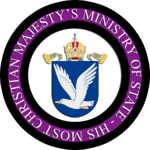 Ministry of State |

|
Gareth Fendara | Solidarity Party | 1 January 2021 - present |
 Ministry of Administration of the Realm |

|
Anaroia Annán | Solidarity Party | 1 January 2021 - present |
 Collegium Scientificum |

|
Fr. Seán Fox, OFM | Non-partisan | 29 April 2013 - present |
 Ministry of the Environment and Energy |

|
Ferínaco Colò | Solidarity Party | 1 January 2021 - present |
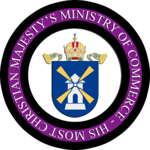 Ministry of Commerce |

|
Michael Maruado | Solidarity Party | 1 January 2021 - present |
 Ministry for the Church in Urcea |

|
Msgr. James Lúcás, SDB | Non-partisan | 18 August 2004 - present |
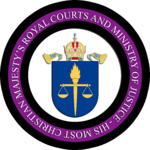 Royal Courts and Ministry of Justice |

|
Archjustice Seán Anmarcus | Solidarity Party | 1 January 2021 - present |
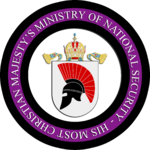 Ministry of National Security |

|
Nica Carmanuel | Solidarity Party | 1 January 2021 - present |
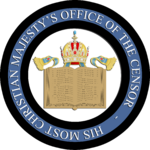 Censor |

|
Aedanicus Gallant | Solidarity Party | 1 January 2016 - present |
 Censor |

|
Victor Fulgentius | Non-partisan | 1 January 2001 - present |